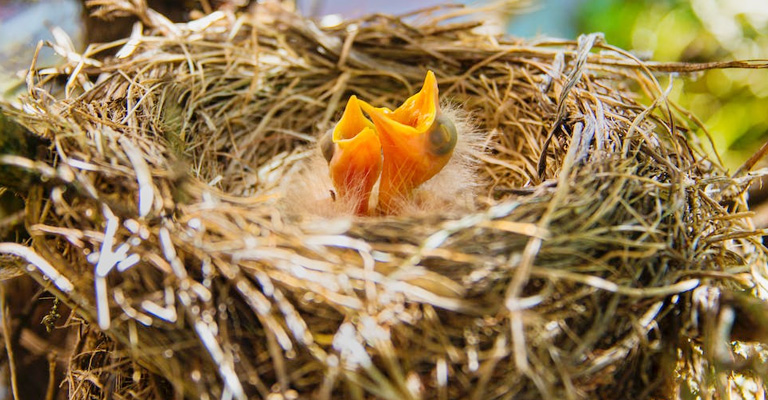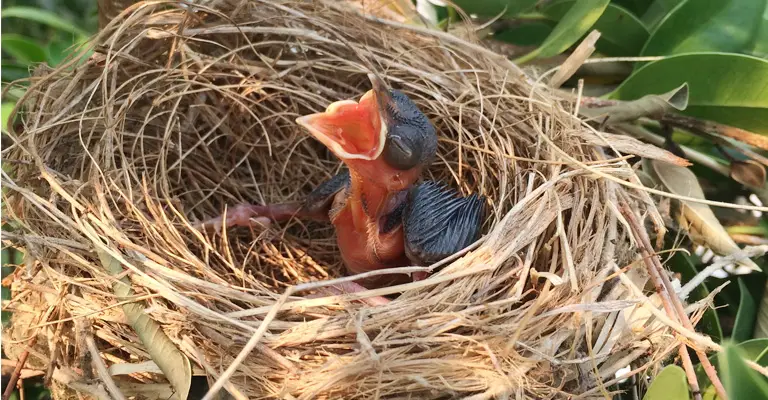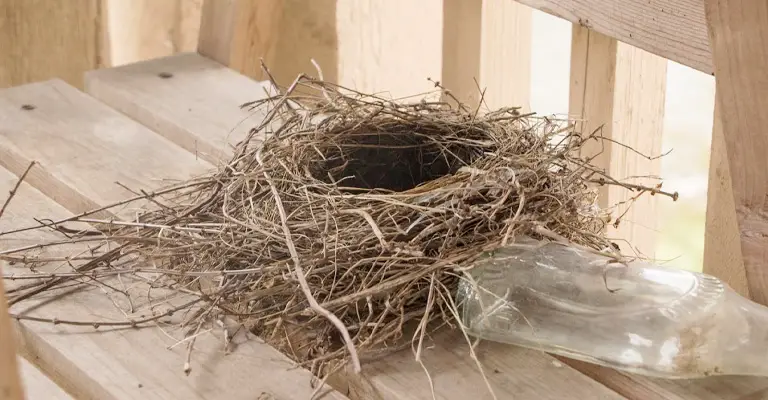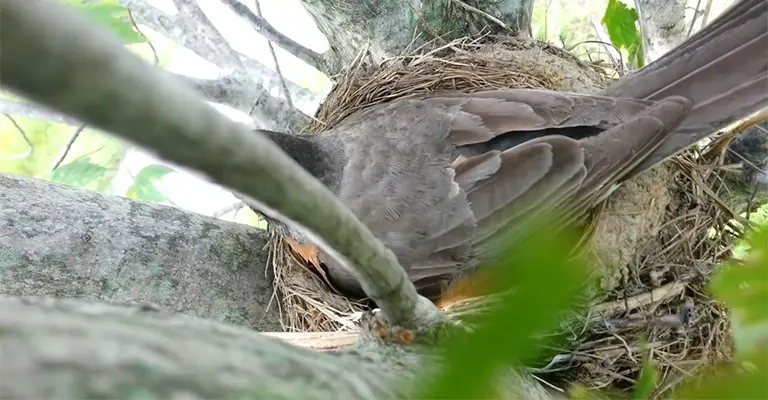Robins are beloved birds known for their vibrant plumage and sweet songs. However, what many of us don’t often see is their incredible parenting dedication, especially during nesting season. Sometimes, a robin’s nest may be in a location that poses imminent threats to both the nestlings and the parents.
In such cases, relocating the nest may be the only option to ensure their safety. This blog post explores the question ‘How to safely relocate a robin’s nest?’, expert guidance, and legal considerations.
Whether it’s due to impending construction, potential dangers, or emergencies, knowing the right steps can make all the difference in preserving these precious avian families.
We’ll provide you with essential tips to ensure that, if relocation becomes necessary, it’s done with utmost care for these remarkable birds.

Robins Nesting Habits
Robins are well-known for their nesting habits, typically building their nests in the spring and early summer. They often choose locations close to a reliable food source, like gardens, parks, or woodlands.
The female robin is primarily responsible for constructing the nest, which is a cup-shaped structure made of twigs, leaves, grass, and mud.
Robins are adaptable and may build nests in a variety of spots, including tree branches, shrubs, ledges, or even man-made structures like window sills or hanging baskets. They tend to favor concealed locations that provide some protection from predators.
Once the nest is complete, the female lays a clutch of pale blue-green eggs and incubates them for about two weeks. During this time, the male may assist with feeding her.
After hatching, both parents share the responsibility of feeding and caring for the chicks until they fledge, which usually takes around two weeks.
Why You Need to Relocate a Robins Nest?
Relocating a robin’s nest should only be considered as a last resort and should be done with caution. It’s generally best to avoid disturbing nesting birds whenever possible because they are protected by laws in many regions, and interfering with their nests can be harmful to the birds.
However, there are some situations where relocation might be necessary for the birds’ safety or if their presence poses a significant problem:
Immediate danger
If the nest is in a location where it is at imminent risk of destruction, such as during construction work or an impending threat, relocation may be necessary to save the eggs or chicks.
Health hazards
If the nest is infested with parasites or disease, relocating it may prevent the spread of illness to other birds.
Human safety
In rare cases, if a robin has built a nest in a location that poses a serious threat to human safety, such as inside a ventilation system or electrical equipment, it may be necessary to relocate the nest.
If you believe relocation is necessary, it’s important to consult with local wildlife authorities or a licensed wildlife rehabilitator who can provide guidance on the appropriate procedures and legal requirements.
Preparation Before Relocating a Robins Nest

Relocating a robin’s nest should be a last resort, as it can be stressful and potentially harmful to the birds. However, if it’s absolutely necessary due to imminent danger or other critical reasons, you should take the following precautions and preparations:
Consult Local Authorities
Check with your local wildlife agency or bird conservation organization to understand the legal regulations and requirements regarding nest relocation. In many places, it may be illegal to disturb nesting birds.
Assess the Situation
Determine whether relocation is truly necessary. Consider if there are any immediate threats to the nest, such as construction, predators, or diseases. Relocation should only be done if the nest and its contents are in imminent danger.
Gather Supplies
You’ll need some basic supplies for the relocation process, including gloves, a small container or box, nesting material (like twigs or grass), and a soft cloth or padding for lining the container.
Timing
Ideally, perform the relocation when the adult robins are away from the nest foraging for food. This minimizes stress and reduces the chance of aggression from the parents.
Be Gentle
Approach the nest cautiously, wearing gloves to minimize human scent. Carefully lift the nest and its contents (eggs or chicks) and place them in the prepared container.
Maintain Temperature
Keep the nest and its contents at a stable temperature, as close to the original location as possible, to prevent chilling or overheating. Avoid excessive jostling during transportation.
Quick Relocation
Relocate the nest to a safer location as close as possible to the original site. The new location should be sheltered and safe from potential threats.
Observe From a Distance
After relocating the nest, monitor it from a distance to ensure that the adult robins return to care for their young. They may take some time to locate the nest in its new location.
Hands-off Approach
Once the nest is successfully relocated, avoid unnecessary disturbances. Allow the parents to continue caring for their chicks without interference.
Remember that relocating a robin’s nest should only be done when absolutely necessary, and it’s best to consult with wildlife experts or rehabilitators who can provide guidance and support during the process.
How to Safely Relocate a Robins Nest?

Here’s a step-by-step process for safely relocating a robin’s nest:
Assess the Threat
Determine if there’s an immediate danger to the nest, such as construction or predators. Only relocate if necessary.
Consult Experts
Contact local wildlife authorities or bird conservation organizations for guidance and legal requirements.
Timing Matters
Choose a time when adult robins are away foraging to minimize stress.
Prepare Supplies
Gather gloves, a secure container, and padding for nest relocation.
Gentle Handling
Approach the nest carefully, wearing gloves to reduce scent transfer. Lift it gently into the container.
Temperature Stability
Keep the nest stable and at a suitable temperature during transportation.
Select a Safe Spot
Relocate to a sheltered, predator-free area nearby, ideally within sight of the original location.
Monitor Quietly
Observe from a distance to ensure the robins return and resume caring for their young.
Avoid Disturbances
Minimize disruptions, keeping pets and others away from the nest site.
Long-term Care
Continue monitoring and seek expert advice if issues arise.
Remember, the goal is to protect robin nestlings while minimizing stress and disturbances during the relocation process.
After Care of Relocating a Robins Nest

After relocating a robin’s nest, it’s essential to provide aftercare to ensure the well-being of the birds. Here are some steps to follow:
Monitor From a Distance
Continue to observe the nest from a safe distance to ensure that the adult robins have found their relocated nest and are caring for their young. It may take some time for them to locate the new site, but once they do, they will resume feeding and protecting their chicks.
Avoid Unnecessary Disturbances
Minimize any potential disturbances around the nest. Keep pets, children, and other potential threats away to reduce stress on the birds.
Provide Food and Water
Ensure that the adult robins have access to food and water sources nearby. They will need to forage for insects and worms to feed their chicks.
Maintain the Nest
If the nest or container was damaged during the relocation process, repair it as needed. Ensure that it remains secure and sheltered from the elements.
Be Patient
Give the robins time to adjust to the new location and carry out their parenting duties. Avoid interfering with the nest unless there is a clear and immediate threat.
Consult Experts
If you have any concerns about the well-being of the birds or if you encounter any issues, consult with local wildlife authorities, bird experts, or wildlife rehabilitators for guidance. They can provide specific advice based on your situation.
Document and Learn
If you are relocating nests due to specific circumstances, such as construction, document the process and the birds’ progress. This information can be valuable for future reference and for understanding robin behavior.
Educate Others
Share your experience and knowledge with neighbors and community members to raise awareness about the importance of protecting nesting birds and their habitats.
Remember that the ultimate goal of relocating a robin’s nest is to ensure the safety and survival of the birds. It’s crucial to approach nest relocation with care, follow best practices, and prioritize the welfare of the birds involved.
Things to Consider While Relocating a Robins Nest
Relocating a robin’s nest is a delicate operation that should be carried out with careful consideration for the birds’ welfare. Here are important factors to keep in mind while relocating a robin’s nest:
Legal Requirements
Check local and state laws regarding the relocation of bird nests. In many places, it may be illegal to disturb nesting birds, and permits may be required for relocation.
Immediate Threat
Relocate the nest only if there is a clear and immediate threat to the birds or their nest, such as impending construction, safety hazards, or other emergencies.
Expert Guidance
Consult with local wildlife authorities, bird conservation organizations, or wildlife rehabilitators for guidance and assistance. They can provide valuable insights, expertise, and legal considerations.
Timing
Choose a time when the adult robins are not actively attending the nest, typically when they are foraging for food. This minimizes stress and reduces the risk of aggression from the parents.
Minimize Human Scent
Wear gloves to minimize the transfer of your scent to the nest or its contents. Human scent can deter adult birds from returning to the relocated nest.
Proper Container
Use a secure and appropriately sized container for the nest and its contents. Line the container with a soft cloth or padding to ensure the birds are comfortable during transport.
Stability and Temperature
Keep the nest and its contents at a stable temperature during transportation, as close as possible to the original location. Avoid excessive jostling or shaking.
Safe New Location
Choose a new location for the nest that provides shelter and protection from predators and environmental factors. Ensure it is away from immediate threats.
Monitor from a Distance
After relocation, monitor the nest from a safe distance to ensure that the adult robins have found their nest and are caring for their young.
Avoid Unnecessary Disturbances
Minimize disturbances around the nest site. Keep pets, children, and potential threats away to reduce stress on the birds.
Provide Food and Water
Ensure that the adult robins have access to food and water sources nearby, as they will need to forage to feed their chicks.
Document and Learn
If you have a specific reason for relocating the nest, document the process and the birds’ progress for future reference and research.
Relocating a robin’s nest should always be a last resort and carried out with the utmost care and consideration for the birds’ well-being.
FAQs
Can I relocate a robin’s nest if it’s built in an unsafe location?
Yes, you can relocate a robin’s nest if there’s an immediate threat. Consult local authorities, wear gloves, move the nest with care, and place it in a nearby, safer spot. Monitor from a distance to ensure the adult robins return to care for their young.
What should I do if I find a robin’s nest in my construction zone?
First, consult wildlife authorities. If relocation is necessary, follow their guidance. Ensure the new location is sheltered, and use a secure container. Monitor the nest from afar, and avoid unnecessary disturbances to let the robins continue their care.
Is it legal to relocate a robin’s nest?
Laws regarding nest relocation vary by location. Check with local authorities or wildlife agencies for regulations and permits. It’s essential to follow legal requirements and consult experts when needed to ensure the birds’ safety.
How can I minimize stress during nest relocation?
Choose a time when the adult robins are away foraging, wear gloves to minimize scent transfer, and handle the nest gently. Keep the nest stable and at a suitable temperature during transportation. Place it in a safe, nearby location to reduce stress.
What if the adult robins don’t return to the relocated nest?
Give them time to find the new location. Continue monitoring from a distance to ensure they come back. If they don’t return after some time, consult with wildlife experts for further guidance on caring for the nestlings or eggs.
Wrapping Up
In our efforts to protect wildlife, the safe relocation of a robin’s nest is a delicate and crucial task. We’ve discussed the importance of legal compliance, expert advice, and minimizing stress during the process. Remember, it’s always best to consult local wildlife authorities or experts before attempting a relocation.
When done correctly, this act of compassion can help ensure the survival of robin nestlings and reinforce our commitment to coexisting harmoniously with the natural world.
By following the guidelines and respecting these feathered parents, we can contribute to maintaining the balance of life in our shared ecosystems and enjoy the beauty of robins for generations to come. Thank you so much.